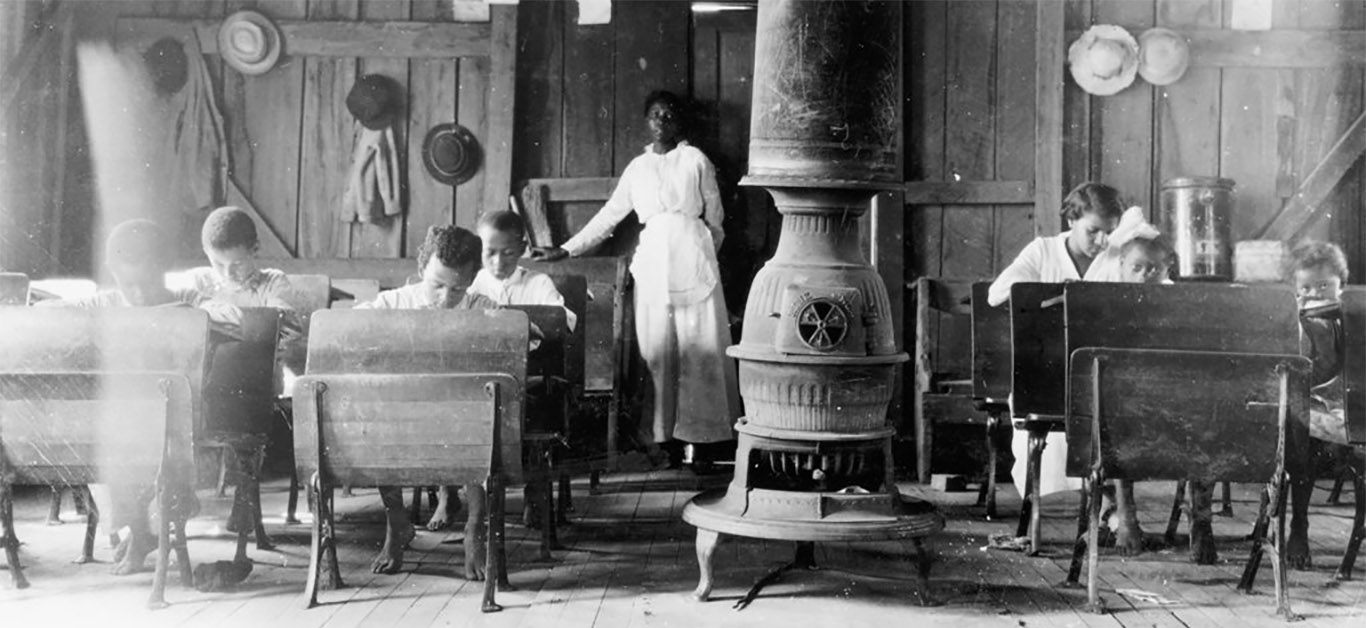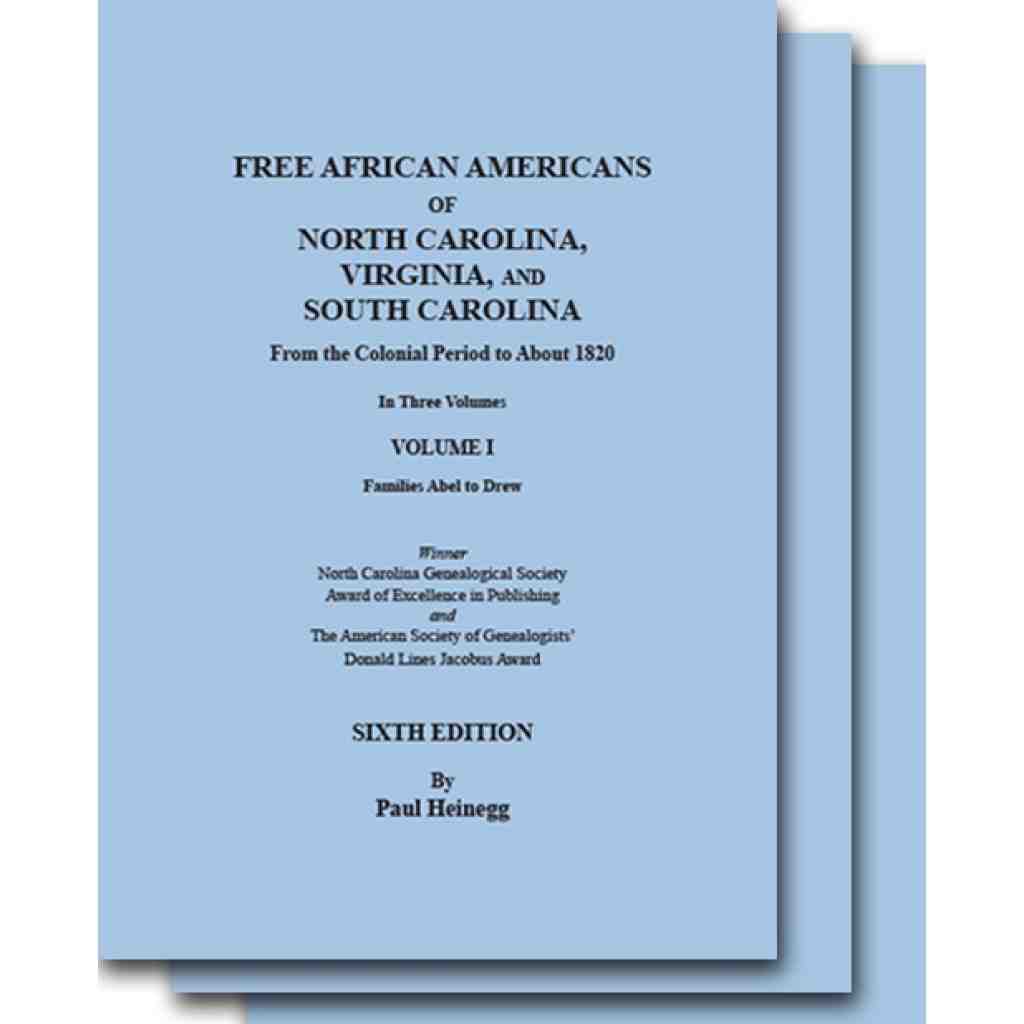
Framework for 6th Edition of Free African Americans of NC, VA & SC
The new 6th Edition of Free African Americans of North Carolina, Virginia & South Carolina from the Colonial Period to About 1820, by Paul Heinegg, contains genealogies of 650 families, 38 more families than found in the 5th Edition. Moreover, Mr. Heinegg has traced most of the families as far as possible from what is available in the public record. The 6th Edition not only sheds new light on its families but also breaks new ground on the nature of race relations in the colonial South. For example, before the system of plantation slavery had fully hardened, Heinegg proves that relationships between blacks and white farmers and farm workers were fluid. Later, however, the passage of apprenticeship laws and anti-manumission statutes in Virginia and North Carolina impacted the fortunes of free African Americans and helped to rigidify the racial status of whites and blacks.
The Introduction to the 6th Edition is nearly 40 pages long and represents an evidence-based, genealogical and historical assessment of the status of whites and blacks in the colonial Upper South. The topics covered include: Virginia Origins of Carolina families, Male and Female “Mulatto” Children, Replacement of White Servants by Slaves, Migration, Land Ownership and Relations with Whites, Race Relations and Relations with Slaves, Discriminatory Taxation, Indentured Apprenticeship, Sale into Slavery, Service in the Revolutionary War, Relations with Indians, and more. Following is an excerpt from the beginning of that Introduction.
INTRODUCTION
“These genealogies, comprising the colonial history of the majority of the free African American families of Virginia and North Carolina, describe the colonial and early national history of their communities:
- Most of the families were the descendants of white servant women who had children by slaves. Over 1,000 free, mixed-race children were born to white women by slaves in Maryland and Virginia during the colonial period.
- Many descended from slaves who were freed before the 1723 Virginia law which required legislative approval for manumissions. The Cumbo, Driggers and Gowen families who were free in the mid-seventeenth century had several hundred members before the end of the colonial period.
- Very few African American families that were free during the colonial period descended from white slave owners who had children by their slaves, less than 1% of the total.
- Many free African American families in colonial North Carolina and Virginia were landowners who were generally accepted by their white neighbors.
- Over 420 free-born African Americans served in the Revolution from Virginia, over 400 from North Carolina and 40 from South Carolina.
- Free Indians blended into the free African American communities. They did not form their own separate communities.
- Some of the light-skinned descendants of free African Americans formed the tri-racial isolates of Virginia, North Carolina, South Carolina, Tennessee, Kentucky, Ohio, and Louisiana.
Virginia Origins
Most of the free African Americans of Virginia and North Carolina originated in Virginia where they became free in the seventeenth and eighteenth century before chattel slavery and racism fully developed in the colonies.
When they arrived in Virginia, Africans joined a society which was divided between master and white servant—a society with such contempt for white servants that masters were not punished for beating them to death in 1624. They joined the same households with white servants—working, eating, sleeping, getting drunk, and running away together [McIlwaine, Minutes of the Council, 1622-1632, 1670-1676, 22-24, 466-7; Northampton Orders 1664-74, fol.25, p.31-fol.31; Hening, Statutes at Large, II:26, 117; Charles City County Orders 1687-95, 468; Westmoreland County Orders 1752-5, 41a].
Some of these first African slaves became free:
- Michael Gowen, a “negro” servant, was freed by the 18 January 1654 York County will of Christopher Stafford [DWO 3:16].
- Emanuel Driggers of Northampton County was free by 1661 [DW 1657-66, fol.123; Orders 1664-74, fol.75, p.78].
- Emanuell Cambow (Cumbo), “Negro,” was granted 50 acres in James City County on 18 April 1667 [Patent Book 6:39].
- John Harris, “negro,” was free in 1668 when he purchased 50 acres in York County [Deeds 1664-72, 327].
- Susannah Carsey was a “free Negro” living in Charles City County in 1677 [Orders 1677-79, 216; 1687-95, 90, 223] and Peter Kersey was a free “Negro” living in Surry County in 1678 [Orders 1671-91, 240, 251; DW 2:236a, 3:13a].
A number of African Americans living on the Eastern Shore [of Virginia] gained their freedom in the seventeenth century. There were at least 33 taxable African Americans in Northampton County in the 1670s who were free, later became free, or had free children. They represented one third of the taxable African Americans in the county.
The Nickens family came from Lancaster County where Black Dick (Richard Nickens), his wife Chris, and their children were freed in 1690 by the will of John Carter [Wills 1690-1709, 5]. The family was associated with the Weaver family, descendants of three East Indian men who were free from their indentures in Lancaster County in 1708.
Some free African Americans were beginning to be assimilated into colonial Virginia society in the mid-seventeenth century and were the result of mixed-race marriages:
- Francis Payne was married to a white woman named Amy by September 1656 when he gave her a mare by deed of jointure [DW 1655-68, fol. 19].
- Elizabeth Key, a “Mulatto” woman whose father had been free, successfully sued for her freedom in Northumberland County in 1656 and married her white attorney, William Greensted [Record Book 1652-8, 66, 67, 85a, 85b].
- Francis Skiper was married to Ann, an African American woman, before February 1667/8 when they sold land in Norfolk County [W&D E:1666-75; Orders 1666-75,73].
- Peter Beckett, a “Negro” slave taxable from 1671 to 1677 in Northampton County, Virginia, married Sarah Dawson, a white servant and had at least four children [OW 1674-79, 203; OW 1683-89, 59].
- Hester Tate, an English woman servant in Westmoreland County, had four children by her husband James Tate, “a Negro slave to Mr. Patrick Spence,” before 1690 [Orders 1690-98, 40-41].
As slaves replaced white servants, the Legislature passed a series of laws which designated slavery as the appropriate condition for African Americans:
- In 1662 the Virginia Assembly enacted the law that a child was free or slave depending on “the condition of the mother.” The child of a slave by a white man was a slave, but the child of a white woman by a slave was free. And white men and women who committed fornication with a Negro were subject to twice the usual fine for fornication [Hening, Statutes at Large, II:270].
- In 1691 the Assembly prohibited the manumission of Negro, Mulatto or Indian slaves unless they were transported out of the colony. It also ordered that white women who had children by a “negro or mulatto” be sold as servants for five years, “for every such offense,” and their children bound out for thirty years [Hening, Statutes at Large, III:86-87].
- In 1705 the Assembly revised the law of 1691 to include the children of Indian servants “by a negro or mulatto” and extended the term of the children’s indentures to thirty-one years. They also all but eliminated the ability of slaves to earn their freedom by ordering that the farm stock of slaves be sold by the churchwardens and the profit applied to the use of the poor [Hening, Statutes at Large, III:453, 459-60].
- In 1712 all fifteen members of the Anderson and Richards families were freed and given 640 acres in Norfolk County, Virginia, by the will of John Fulcher, creating such a stir that the Legislative Council on 5 March 1712/3 proposed that the Assembly provide a Law against such Manumission of Slaves, which in time by their increase and correspondence with other Slaves may endanger the peace of this Colony [McIlwaine, Executive Journals of the Council, III:332].
- In 1723 the Virginia Assembly prohibited the freeing of “negro, mulatto or indian” slaves except in cases where they had rendered some public service such as foiling a slave revolt, and amended the 1705 taxation law to make female “negros, mullattos and indians” (except tributary Indians) over the age of sixteen tithable. It also ordered that any child born to a female “mullatto or indian” serving a thirty or thirty-one-year indenture serve until the same age as their mother was obliged to serve [Hening, Statutes at Large, IV:132-3].
Despite the efforts of the legislature, white servant women continued to bear children by slave fathers through the late seventeenth century and well into the eighteenth century. From these genealogies, they were the primary source of the increase in the free African American population from 1723 until 1782 when Virginia relaxed the laws against manumission. White women had over 500 children by slaves or free African American fathers in Virginia during the colonial period. Many of these women may have been the common-law wives of slaves since they had several mixed-race children. They were the ancestors of the majority of the families in this history. Fifty families descended from freed slaves, twenty-nine from Indians, and nineteen from white men who married or had children by free African American women. It is likely that the majority of the remaining families descended from white women since they first appear in court records in the mid-eighteenth century when slaves could not be freed without legislative approval, and there is no record of legislative approval for their emancipations . . . .”

Free African Americans of North Carolina, Virginia, and South Carolina, From the Colonial Period to About 1820. Sixth Edition, Three-Volume Set
The Third Edition of Paul Heinegg’s Free African Americans of North Carolina and Virginia was awarded the American Society of Genealogists’ prestigious Donald Lines Jacobus Award for the best work of genealogical scholarship published between 1991 and 1994. The new Sixth Edition is Heinegg’s most ambitious effort yet to reconstruct the history of the free African American communities o…
Recent Blog Posts




